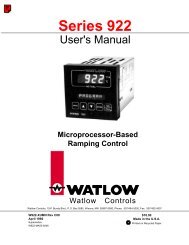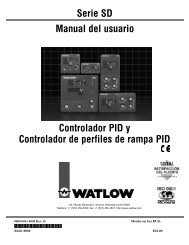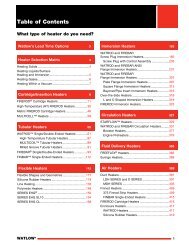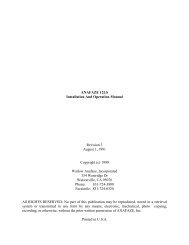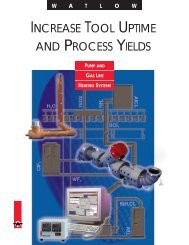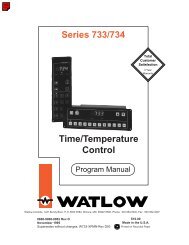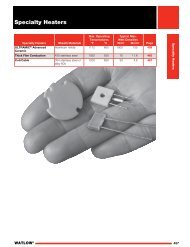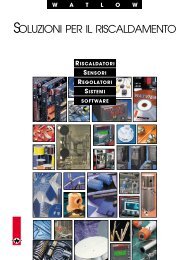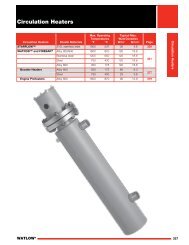RADIANT HEATING WITH INFRARED - Watlow
RADIANT HEATING WITH INFRARED - Watlow
RADIANT HEATING WITH INFRARED - Watlow
You also want an ePaper? Increase the reach of your titles
YUMPU automatically turns print PDFs into web optimized ePapers that Google loves.
Problem Solving<br />
Warning:<br />
Calculations provide good results<br />
when all the variables are known and<br />
all the heat loads are included. In<br />
real world applications, many<br />
assumptions are made.<br />
<strong>Watlow</strong> recommends that tests be<br />
performed to substantiate<br />
calculations whenever possible.<br />
<strong>Watlow</strong> has extensive testing facilities<br />
to evaluate the radiant heat<br />
requirements of your process. In<br />
cases where sending samples to<br />
<strong>Watlow</strong> is not feasible, test heaters<br />
and controls for on-site testing at<br />
your location are available. Your local<br />
<strong>Watlow</strong> representative is available to<br />
help you with product testing at<br />
either your facility or <strong>Watlow</strong>’s.<br />
Density and specific heat for many<br />
materials can be found in the<br />
<strong>Watlow</strong> Application Guide.<br />
14<br />
Steps to Solving Radiant Application Problems<br />
Broadly speaking, there are three steps to determining the correct radiant<br />
heater solution for an application:<br />
First, collect the necessary application information. Sometimes educated<br />
guesses are required here, but, remember, that the accuracy of the<br />
calculations depends on the accuracy of the numbers put into them.<br />
Second, calculate how much wattage is required to produce the desired<br />
temperature change in the product. This part of the problem is solved using<br />
the conventional heat transfer equations and problem solving methods. It<br />
does not involve radiant heat calculations.<br />
Third, determine what radiant heater size and temperature is needed to put<br />
the required wattage into the product. For this, use the radiant heat transfer<br />
equation.<br />
Step 1: Collect Application Information<br />
• Initial and final material temperature<br />
• Heat-up time<br />
• Specific heat of material<br />
• Density or weight of material<br />
• Material size<br />
• Heat of vaporization/fusion of material, if applicable<br />
• Conveyor speed, if applicable<br />
• Emissivity of material or absorption spectrum<br />
• Heater to material distance<br />
• Proposed heater layout: size, spacing, heating one or both sides<br />
• Are there secondary heat loads, such as air, conveyor, etc.?<br />
Step 2: Determine the Required Wattage<br />
Use conventional heat transfer equations to determine the wattage<br />
that must be absorbed by the material to produce the desired<br />
changes. The most commonly used equations are listed below:<br />
Change in Temperature:<br />
W/in 2 = Weight (lbs)/in 2 x Specific Heat x Change in Temperature (°F)<br />
Time (hr) x 3.412 BTU/watt hr<br />
Change in State:<br />
W/in 2 = Weight (lbs)/in 2 x Heat of Fusion or Vaporization<br />
Time (hr) x 3.412 BTU/watt hr<br />
These equations determine how much heat must go into the<br />
product. In many cases, convection losses from the product can be<br />
neglected; since the ambient air between the radiant heater and<br />
product is usually hotter than the product, some convection heating<br />
takes place. If air is vented through the oven to carry away solvents<br />
or water vapor, then the wattage used to heat this air must be<br />
considered.



